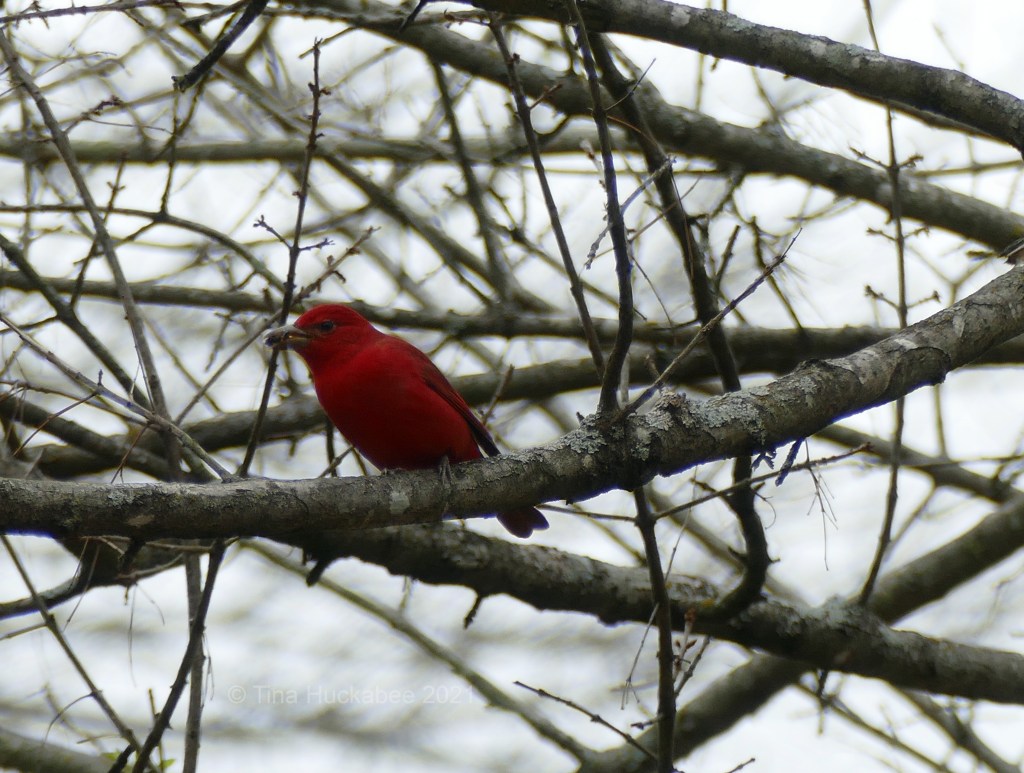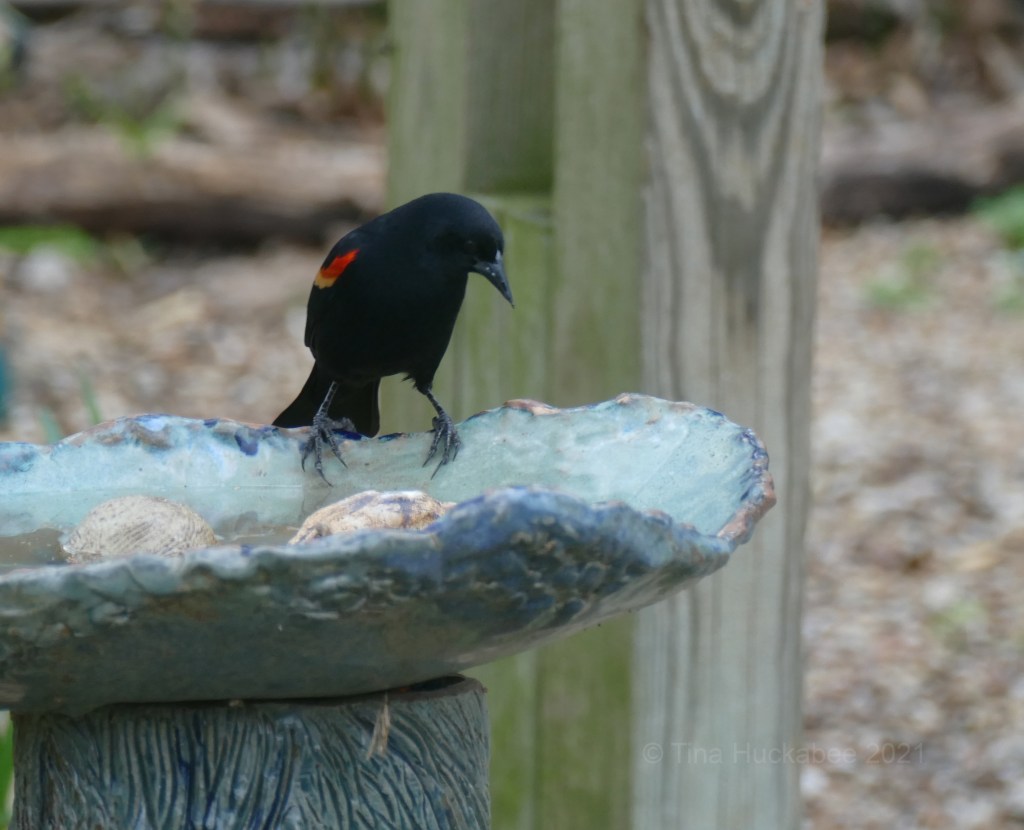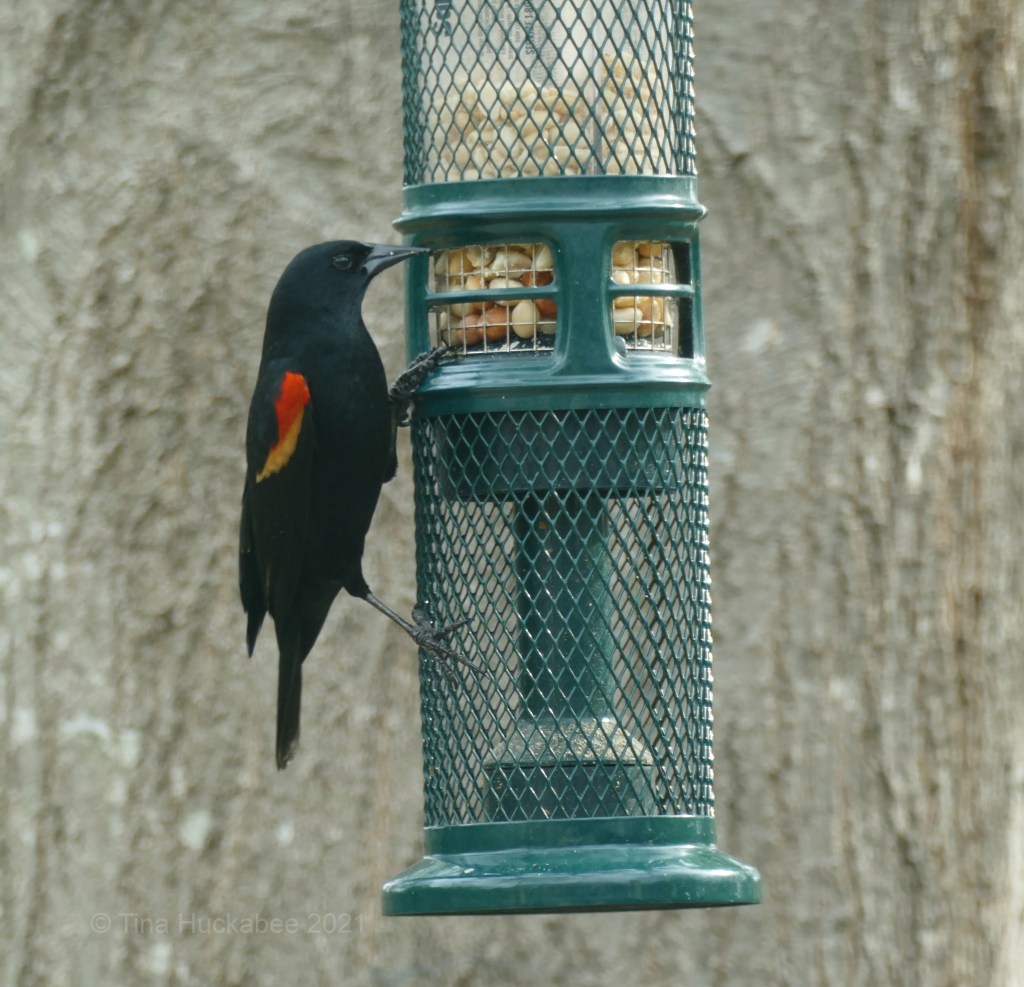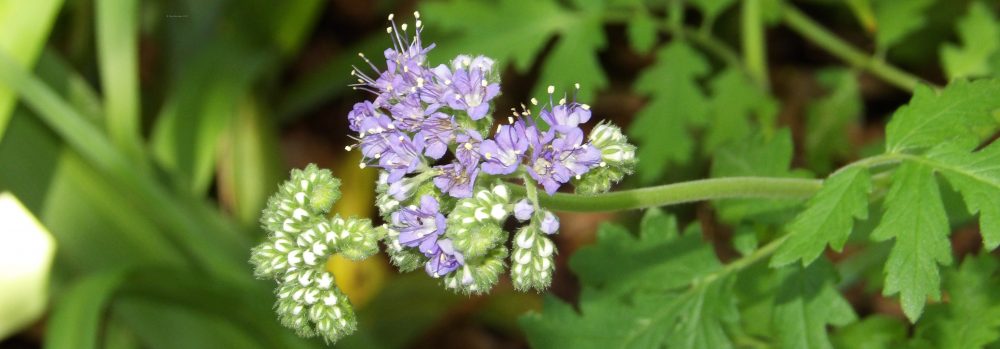In my garden, red-n-black doesn’t lack–in bird colors. It’s that time of year, when the colorful migratory birds wing through Texas and (lucky me!) some visit my garden.
In early April, I always see one or more Summer Tanagers, Piranga rubra, who show up to snack on honeybees and native bees. These scarlet hunters are adept at catching the bees on the wing as both birds and bees flit through the garden.
If you look closely at this striking adult male, you’ll see something in his beak–it’s a honeybee.

In this shot, you can see the wings of the bee meal, the red menace in the process of whacking the hapless bee against the branch, effectively killing the bee and making it easier for the tanager to remove the stinger. That’s probably a good idea, considering that the bird is going to have the bee in its beak and down its gullet.

The snack is ready for the eating! I was able to capture these shots because my poor Red oak trees are late in leafing out after the snow/ice storm in February and is lacking in leafy lushness.

In a more colorful photo, the gorgeous guy perches in the freeze damaged, but partially foliaged, Mountain Laurel.

No meal is complete without a complementary aperitif, and what better drink to go with honeybee meal than pond water?

Or, perhaps it was just time to take a bath!

The brief April visits from this species is typically in the form of adult females and juvenile males, who are just as beautiful as this year’s male: golden feathers for the female and splotchy red and yellow for the youngster. Mr. Male was only here for a matter of minutes; I hope more of these tanager treats show up in my garden.
Another annual spring migratory visitor are Red-winged Blackbirds, Agelaius phoeniceus. I have a tough time catching these stunning birds as they’re quick with their seed and peanut eating, plus they fly off at the slightest movement. I was lucky to snap a photo of this handsome chap as he enjoyed a sip at the bar.

The male Red-winged Blackbird is a velvety, deep black, with underwing highlights of deep red and rich yellow. Their underwing colors are more visible when the bird is in flight, but significantly more challenging to photograph. But I’m content with this capture of his profile of midnight black, with bits of cheery color, and bright eye to complete the bird package.

Bird stories, garden stories–get your fill by popping over to Anna at Wednesday Vignette. Happy reading!

Fantastic captures, Tina – these are gorgeous birds!
LikeLike
Thanks so much, Eliza. The birds were cooperative!
LikeLiked by 1 person
Oh, beautiful photos! I always expect the scarlet tanagers around early May here, but we’re about two weeks early with so many things this year. I have the oranges out for the orioles, and soon I’ll put out the hummingbird feeders. Exciting times!
LikeLike
Thank you, Beth. I’m sure you’ll be seeing “my” migrants very soon and you’ll get to enjoy them, too!
LikeLike
Beautiful birds – none of which I think I’ve ever encountered. You take fabulous photos, Tina!
LikeLike
Thank, Anna. I was happy with those shots, but I take quite a few that are duds. The birds are never duds, though!
LikeLiked by 1 person
Beautiful visitors indeed!
LikeLike
I agree!
LikeLike
Red-n-black
Doesn’t lack;
Birds are back,
Cut no slack,
Take a snack,
Off they pack.
LikeLike
You’re good, Steve–your comments always make me smile-or giggle, in this case.
LikeLike
And each birdie does a wiggle
That can’t help but make you giggle.
LikeLike
lol
LikeLike
Lovely images and stories.
LikeLike
Thank you!
LikeLike
More great photos! I guess that is one plus for the lack of leaves. I can hear the Tanagers in the trees, but rarely see them. The first Tanager I ever saw was after Ike. It was a female and I thought it was a sick Cardinal.
LikeLike
Haha–that’s my take: no leaves, easier to see the birds. I only get these tanagers for a brief time, but they’re consistent, so I keep an eye out for them each and every early April.
LikeLiked by 1 person
Great shots. We occasionally see scarlet tanagers.
LikeLike
I’ve never seen a scarlet tanager, but they migrate through here.
LikeLiked by 1 person
My first lesson here was that it’s ‘tanager,’ not ‘tananger.’ That aside, if I’d seen your bird, I would have thought it was a scarlet tanager. After a little extra exploration at the Cornell site, I discovered the error of my ways! They’re quite different birds.
I love the red-winged blackbirds! They’re one of the birds that were common both in Iowa and here on the coast. I often found them singing from cornstalks there; here, they love perching on the cattails and filling the air with song.
LikeLike
Yes, it’s weirdly tempting to add that extra ‘n’! And you’re one up on me, as I’ve never seen a Scarlet tanager, but I know they’re around here, just not around me!
Red-winged Blackbirds are one of my favorites. So beautiful and I love their various calls–pure sopranos!
LikeLike
Tina your visitors are very beautiful. Summer tanagers are beautiful with their red color and they are good bee hunters, I love them. The series of photos of thongs is magnificent, I love it. After bathing in the male’s pond, how handsome he gets, I love it. The male Red-winged Blackbird is a unique beauty, I love it. How they like to eat peanuts and are fast eating. He’s gorgeous at the bar drinking water, I love them. The photos of the red-winged blackbirds are fabulous. You have wonderful singers. Tina take good care of you and Bee Daddy. I hope you are already vaccinated or you will be vaccinated soon. My dear Mother was given the first dose on April 9 and the second dose was given on April 30. I have an appointment for the first dose on May 10th. Best wishes to both of you. Happy week. Very affectionate greetings from Margarita.
LikeLike
Gracias, Margarita! I love seeing these pretty birds, they brighten the garden.
Yay for you and your mother! I’m so glad you’re both getting the vaccinations. Good luck! We’re getting our second dose tomorrow; so relieved!
LikeLiked by 1 person
Congratulations Tina, you are already vaccinated with the two doses of Bee Daddy and you !! My mother has a week left for the second dose and my first dose of the vaccine has been delayed because there are not enough vaccines and they want to give priority to people between 60 and 69 years of age. They will call me on the phone when I get the first dose of the vaccine, I hope it will be soon! A hug. Very affectionate greetings from Margarita.
LikeLike
Thanks, Margarita! I hope you’ll be vaccinated very soon and glad your mother is getting hers. Meanwhile, stay safe and sound!
LikeLiked by 1 person
Thank you very much Tina. Take good care of each other and keep both of you safe even if you are vaccinated, because the Covid is very treacherous. Hugs. Very affectionate greetings from Margarita.
LikeLike